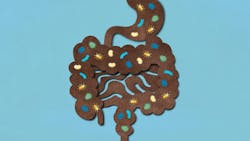Postbiotics against the pathobionts: A new chapter
What you'll learn in this article
- How postbiotics suppress oral pathogens and disrupt biofilms without relying on live microorganisms, lowering risks linked to antibiotic resistance and aspiration pneumonia
- Ways postbiotics in toothpaste, gels, and rinses can raise salivary IgA, support beneficial microbiota, and reduce inflammation—and how the dental team can track these effects during care
- How clinical studies compare postbiotic-based products to chlorhexidine for gingival inflammation control, with potential advantages in safety and patient compliance
- Why postbiotics may be especially useful for pediatric and periodontal patients through immune modulation, microbiome balance, and caries prevention support
This is not a tale of the Six Million Dollar Man; think of it as a dive into education ... with bionic enhancements. This article explores the increasingly nuanced world of postbiotics. From probiotics and prebiotics to synbiotics, postbiotics, and cutting-edge innovations like lantibiotics, each brings its own mode of action and clinical potential to the evolving landscape of oral health.
Among them, postbiotics are gaining heightened attention for their stability, safety, and ability to modulate the oral microbiome without the need for viable organisms. Defined by the International Scientific Association for Probiotics and Prebiotics (ISAPP) as “a preparation of inanimate microorganisms and/or their components that confers a health benefit on the host,” postbiotics stand apart from traditional live probiotics due to their nonviable nature and targeted health effects.1 Unlike probiotics, they don’t need to survive GI transit or colonize the mouth—but they still exert immunomodulatory and antimicrobial effects. Postbiotics function through several mechanisms, including inhibiting pathogenic bacteria with antimicrobial compounds, disrupting biofilm formation, modulating immune responses, and influencing bacterial gene expression—all without requiring live microbial cells.
Postbiotics, a promising and practical solution
In the field of oral health, postbiotics represent a promising and practical solution, particularly in environments where reliability, shelf life, and ease of formulation are necessary. Their nonliving nature allows for incorporation into a wide range of dental products like toothpaste, mouthwashes, gels, and lozenges, without the risk of bacterial degradation or diminished potency. For example, postbiotics have long been preferred in the manufacturing of canine dental care products due to their compatibility with heat, moisture, and other processing challenges.1
Postbiotics include inactivated microbial cells and their bioactive metabolites like organic acids, bacteriocins, secretory proteins, cell wall components (e.g., peptidoglycans, lipoteichoic acids), biosurfactants, and short-chain fatty acids (SCFAs). These compounds help maintain microbial balance in the oral cavity by directly suppressing pathogenic bacteria while supporting the growth of beneficial species.1,2
An immunomodulatory effect
One of the key benefits of postbiotics is their immunomodulatory effect. In a randomized controlled clinical trial (RCT), the use of toothpaste containing inactivated strains of Lactobacillus salivarius, L. paracasei, and L. acidophilus increased salivary immunoglobulin A (IgA) levels and SCFA concentrations, while reducing harmful species such as Klebsiella and Escherichia.2 Klebsiella is rarely found in healthy mouths but is more frequently detected in hospitalized or immunocompromised individuals, as well as in patients with periodontitis, oral squamous cell carcinoma, and oral candidiasis.3 It’s known for forming biofilms and exhibiting antibiotic resistance, complicating oral infections that can be aspirated into the lungs, and contributing to aspiration pneumonia. Escherichia coli, while a normal inhabitant of the gastrointestinal tract, is not typically found in the healthy oral cavity and is considered a marker of dysbiosis when present. However, it has been found in peri-implantitis, periodontitis, and immunocompromised individuals.4,5
Another study demonstrated that postbiotic metabolites derived from Lactiplantibacillus plantarum PD18 significantly inhibited the growth and biofilm formation of pathogens, including Streptococcus mutans (Sm), Porphyromonas gingivalis (Pg), Tannerella forsythia (Tf), and Prevotella loescheii (Pl). The inhibition rates were as high as 92.95% for Sm and 89.68% for Pg.6 While Pl may not receive as much attention in oral health and is considered less virulent than the well-documented pathogen Prevotella intermedia (Pi), it may still contribute to polymicrobial biofilms—particularly in the early stages of biofilm formation or under conditions of oral dysbiosis.
Clinical comparisons between postbiotic-based formulations and conventional agents like chlorhexidine have also been made. In an RCT involving periodontal patients, an antimicrobial gel containing postbiotics, lactoferrin, and aloe barbadensis leaf juice powder demonstrated comparable, if not superior, outcomes to a conventional chlorhexidine gel in reducing gingival inflammation and improving oral hygiene.7 In addition to their antimicrobial action, postbiotics can modulate oxidative stress pathways. Postbiotics have been shown to activate the nuclear factor erythroid 2-related factor 2 (Nrf2) pathway, enhancing antioxidant enzyme expression and reducing oxidative damage, which is relevant in periodontal disease management.8 Both Twetman and Belstrøm (2025) and Jiang et al. (2024) recognize the value of postbiotics as adjuncts to conventional periodontal therapies like scaling and root planing. These supplements support clinical outcomes by modulating inflammation, reducing pathogenic biofilms, and promoting microbiome resilience during periodontal treatment.9,10
A comprehensive 2025 review highlighted the clinical use of postbiotics in reducing dental caries by inhibiting the growth of cariogenic bacteria, modulating oral microbiota, enhancing host immunity, and maintaining neutral mouth pH.11,12 There were notable limitations, including the predominance of in vitro studies that may not capture the complex interactions within the oral cavity, short follow-up durations, and heterogeneity in the strains and formulations used.
New avenues of innovation
Postbiotics have also been explored in the management of halitosis. Another RCT found postbiotics derived from Lactobacillus paracasei ET-22 were effective in reducing oral malodor and restoring oral microbiome balance.13 Postbiotics possess antibacterial, anticariogenic, and anticancer properties that may aid in oral cancer prevention and therapy. Their ability to modulate the immune environment and suppress cancer-promoting pathogens has positioned postbiotics as a unique consideration in prevention and adjunctive oral cancer care.14
When legacy paths begin to narrow, innovation offers new avenues—and in the case of caries prevention for children, the need for progress is pressing. Postbiotic interventions have shown promise at enhancing oral immunity and reducing cariogenic bacteria in children. A study in children ages 6-12 demonstrated that postbiotic toothpaste increased salivary IGA levels, an important component of mucosal immunity.15
As a new frontier in preventive dentistry, postbiotics are poised to become a cornerstone of functional, microbiome-focused oral care. Their safety, stability, and ability to confer health benefits without relying on live microorganisms make them uniquely suited for integration into oral care products. Their actions are subtle but cumulative. They may not kill pathogens outright like antiseptics, but instead they suppress virulence gene expression, interfere with quorum sensing, disrupt biofilm communication, and could normalize host immune responses. We can rebuild it; we have the knowledge.
Editor's note: This article appeared in the August/September 2025 print edition of RDH magazine. Dental hygienists in North America are eligible for a complimentary print subscription. Sign up here.
References
- Salminen S, Collado MC, Endo A, et al. The International Scientific Association of Probiotics and Prebiotics (ISAPP) consensus statement on the definition and scope of postbiotics. Nat Rev Gastroenterol Hepatol. 2021;18(9):649-667. doi:10.1038/s41575-021-00440-6
- Rui W, Zhong S, Li X, Tang X, Wang L, Yang J. Evaluating the role of postbiotics in the modulation of human oral microbiota: a randomized controlled clinical trial. Probiotics Antimicrob Proteins. 2024. Published online: March 19, 2024. doi:10.1007/s12602-024-10238-y
- Kumar PS, Griffen AL, Moeschberger ML, Leys EJ. Identification of candidate periodontal pathogens and beneficial species by quantitative 16S clonal analysis. J Clin Microbiol. 2005;43(8):3944-3955. doi:10.1128/JCM.43.8.3944-3955.2005
- Lourenço TG, Heller D, Silva-Boghossian CM, Cotton SL, Paster BJ, Colombo AP. Microbial signature profiles of periodontally healthy and diseased patients. J Clin Periodontol. 2014;41(11):1027-1036. doi:10.1111/jcpe.12302
- Takeshita T, Matsuo K, Furuta M, et al. Distinct composition of the oral indigenous microbiota in South Korean and Japanese adults. Sci Rep. 2014;4:6990. doi:10.1038/srep06990
- Butrungrod W, Chaiyasut C, Makhamrueang N, Peerajan S, Chaiyana W, Sirilun S. Postbiotic metabolite of Lactiplantibacillus plantarum PD18 against periodontal pathogens and their virulence markers in biofilm formation. Pharmaceutics. 2023;15(5):1419. doi:10.3390/pharmaceutics15051419
- Butera A, Gallo S, Pascadopoli M, Taccardi D, Scribante A. Home oral care of periodontal patients using antimicrobial gel with postbiotics, lactoferrin, and aloe barbadensis leaf juice powder vs. conventional chlorhexidine gel: a split-mouth randomized clinical trial. Antibiotics (Basel). 2022;11(1):118. doi:10.3390/antibiotics11010118
- Karaca B, Yilmaz M, Gursoy UK. Targeting Nrf2 with probiotics and postbiotics in the treatment of periodontitis. Biomolecules. 2022;12(5):729. doi:10.3390/biom12050729
- Twetman S, Belstrøm D. Effect of synbiotic and postbiotic supplements on dental caries and periodontal diseases–a comprehensive review. Int J Environ Res Public Health. 2025;22(1):72. doi:10.3390/ijerph22010072
- Jiang X, Lin M, Xiao P, Zhou Z, Zhang Y, Yan W. The mechanisms and application value of postbiotics in caries prevention and management. Oral Health Prev Dent. 2024;22:465-478. doi:10.3290/j.ohpd.b5740317
- Heidari F, Heboyan A, Rokaya D, et al. Postbiotics and dental caries: a systematic review. Clin Exp Dent Res. 2025;11(1):e70114. doi:10.1002/cre2.70114
- Banakar M, Fernandes GVO, Etemad-Moghadam S, et al. The strategic role of biotics in dental caries prevention: a scoping review. Food Sci Nutr. 2024;12(11):8651-8674. doi:10.1002/fsn3.4473
- Wuri G, Liu F, Sun Z, et al. Lactobacillus paracasei ET-22 and derived postbiotics reduce halitosis and modulate oral microbiome dysregulation – a randomized, double-blind placebo-controlled clinical trial. Food Funct. 2023;14(16):7335-7346. doi:10.1039/d3fo02271d
- Mohd Fuad AS, Amran NA, Nasruddin NS, Burhanudin NA, Dashper S, Arzmi MH. The mechanisms of probiotics, prebiotics, synbiotics, and postbiotics in oral cancer management. Probiotics Antimicrob Proteins. 2023;15(5):1298-1311. doi:10.1007/s12602-022-09985-7
- Basir L, Moghimipour E, Saadatzadeh A, Cheraghian B, Khanehmasjedi S. Effect of postbiotic-toothpaste on salivary levels of IgA in 6- to 12-year-old children: study protocol for a randomized triple-blind placebo-controlled trial. Front Pediatr. 2022;10:1042973. doi:10.3389/fped.2022.1042973
About the Author

Anne O. Rice, BS, RDH, CDP, FAAOSH
Anne O. Rice, BS, RDH, CDP, FAAOSH, founded Oral Systemic Seminars after over 35 years of clinical practice and is passionate about educating the community on modifiable risk factors for dementia and their relationship to dentistry. She is a certified dementia practitioner, a longevity specialist, a fellow with AAOSH, and has consulted for Weill Cornell Alzheimer’s Prevention Clinic, FAU, and Atria Institute. Reach out to Anne at anneorice.com.
